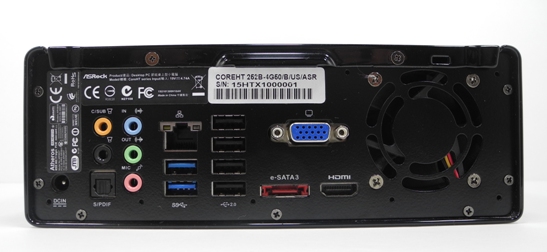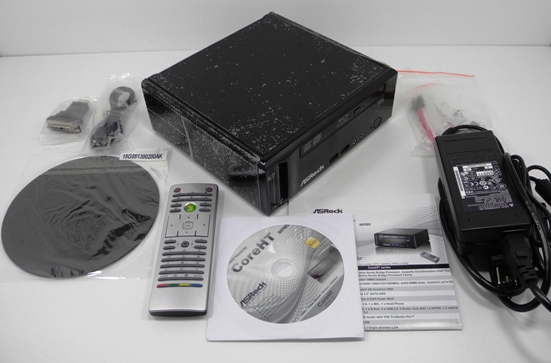ASRock CoreHT 252B Review
by Ganesh T S on September 2, 2011 3:45 AM EST- Posted in
- HTPC
- Intel
- ASRock
- Media Streamer
The ASRock CoreHT 252B package contained the following:
- Main unit in a 2.5L chassis (195mm x 186mm x 70mm)
- 90W AC / DC adapter
- Media Center remote with batteries
- Support CD with drivers and miscellaneous software
- HDMI - DVI dongle
- SATA and power cables / screws for user installation of second hard disk
- 3.5mm audio cable
- Anti-slip base pad for the main unit
The industrial design is nothing to write home about. The pleasing rounded edges are reserved for the higher end Vision series. The CoreHT series has to make do with a sharp edged chassis very similar to the first generation Core 100HT.
When compared with the Core 100 from last year, we find that two of the USB 2.0 ports at the rear end of the unit become USB 3.0 ports in the CoreHT. The front panel remains the same except for the structure of the ventilation slot which is now curved in (instead of the planar slots in the Core 100) and the shape of the power button is now circular instead of the square in the last generation unit.


Just like a notebook, this unit also supports simultaneous display on two monitors. Testing was done mostly with the HDMI output connected to a Toshiba REGZA 37" 1080p TV through an Onkyo TX-SR 606. For non-media playing related testing, the HDMI port was connected to an Acer H243H 1080p monitor.
Our review unit shipped with Windows 7 x64 Ultimate and a OEM version of Cyberlink PowerDVD for Blu-Ray playback. However, the OEM version doesn't support 3D Blu-rays and is also crippled with respect to the number of audio channels that can be decoded / HD audio passthrough. To test these, we installed the full versions of both Cyberlink PowerDVD 11 as well as ArcSoft Total Media Theater 5.
We will conclude this section with a table to summarize the data and A/V connectivity options for the ASRock CoreHT 252B HTPC.
| Option | Status |
|---|---|
| HDMI | Yes [v1.4a] |
| Component | No |
| Composite | No |
| VGA | Yes |
| SPDIF | Yes [Optical] |
| Stereo |
Yes |
Data Connectivity Options for the ASRock CoreHT 252B
| Option | Status |
|---|---|
| Optical Disk Drive | Yes [Blu-Ray / DVD-RW] |
| USB | Yes [4 x v2.0, 4 x v3.0] |
| eSATA | Yes [1 x v3] |
| LAN | Yes [ 1000 Mbps GbE ] |
| Internal HDD | Yes [ 500 GB ] |
| WiFi | Yes [ 300 Mbps 2T2R 802.11n ] |
| Card Reader | No |











54 Comments
View All Comments
Death666Angel - Friday, September 2, 2011 - link
<<Well, the reviewer only used Windows, hence assuming that one pays for it.>>That would be true, except for the part where in the table on the first page, he writes:
"Operating System Windows 7 Home Premium 64-bit (Retail unit is barebones)"
I agree, however, that he could have stated it clearer in the text when he mentioned the software being shipped with the system ("Our review unit shipped with Windows 7 x64 Ultimate and a OEM version of Cyberlink PowerDVD for Blu-Ray playback.").
ganeshts - Friday, September 2, 2011 - link
Guys, I am keeping track of the developments in the Linux HTPC space.As soon as we can get to a point where it is possible to play Blu-rays with menus (we can already playback encrypted Blu-rays with MakeMKV installed, just not with menus -- this was the state when I last looked at it), we will carry out a detailed Linux HTPC article.
Rick83 - Friday, September 2, 2011 - link
Thanks, looking forward to that!bobbozzo - Friday, September 2, 2011 - link
Hi Ganesh,I don't care about BD so I'd like to see a review even if BD menus don't work.
Thanks for all the HTPC articles!
Miles Prower - Saturday, September 3, 2011 - link
I'm considering buying this machine too, as both a lightweight desktop PC (hey, why not) and a HTPC. Both solutions running Linux.I'd llove to see a review considering XBMC performance and hardware support!
cjs150 - Friday, September 2, 2011 - link
"The unit has a noise level of less than 36 dB at full load "Not good enough. The system needs to be much better 30dB or less. Then there is the issue of how noisy is the Blu-ray drive. In my AV rack the one aspect which really annoys me is the Sony Blu ray player which is clearly audible at quiet points in movies. So would really like to know how loud the optical drive is (why do case manufacturers no include some dampening?)
Having said that it is clearly a very good system . Problem is that Zotac have just announced their AD10 nano system. Whilst it is over priced and lacks an optical drive (not a problem for me as store movies to NAS), in a main room it just looks a far better piece of kit, and a lot smaller (and allegedly quieter)
pvdw - Friday, September 2, 2011 - link
"27 dB during Disc Playback"cjs150 - Friday, September 2, 2011 - link
Oops missed that in the charts.Much better, but I do wonder how much of that noise is due to the Blu ray drive - 22.4 dB on idle and 27 dB on Blu ray playback does not really help me - was this playback from HD or from the optical drive. I can believe the number if from HD, I do not believe the number if from optical drive, but if it is correct then I am impressed. Maybe it is just me, but case manufacturers have spent some time putting vibration dampening grommets for hard disks but never for the optical drives - why? A bit of care might reduce the noise considerably.
The problem is that we keep getting quoted dB and how something is so quiet it is effectively silent when clearly it is not. The standard I work to is very simple. If I can hear a computer during a quiet section of a movie or a song, than it is too loud.
ganeshts - Friday, September 2, 2011 - link
Disc = optical drive. The extra noise is due to the operation of the ODD. Yes, I agree with your metric that if people hear it, it is noisy. However, different people have different tolerance / hearing levels. So, you do need to have some sort of base metric to compare against. For example, at 2 ft, I find 36 dB quite audible. But, only during quiet scenes in the video.Rick83 - Friday, September 2, 2011 - link
note that the measurements were done at 2 feet and not the more or less standardized meter. I'm not going to make the transformation now, as I'm not to keen to get into exponential scaling at this time of day, but it's always important to keep the context of db(A) measures in mind when comparing values.